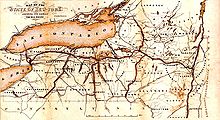
The Canal Ring was a group of corrupt contractors and their political supporters in the 1860s and 1870s who defrauded the State of New York by overcharging for repairs and improvement of the state's canal system. It consisted largely of a group of loosely organized Democratic and Republican Assemblymen and State Senators, led by Jarvis Lord in the Assembly and William Johnson in the Senate. The firm Belden & Denison made the most money from the scam, though numerous contractors were involved.
They were chiefly organized along the route of the Erie Canal; in Syracuse, Rochester, Buffalo, Lockport, and Oswego. Frauds peaked in 1872, with "Appropriations for Extraordinary Repairs" rising to $4.1 million.[1]
Then Governor of New York Samuel J. Tilden began targeting the ring in 1874. In March 1875, he released a report detailing frauds carried out. This served as a direct appeal to the people, and so aroused public opinion that the legislature was forced to authorize the governor to appoint a canal commission. The reports of this commission resulted in a marked diminution in the appropriation for canals and the indictment of several officials for defrauding the State. His handling of the Ring is credited with helping Tilden secure the Democratic nomination for president in 1876.[1]